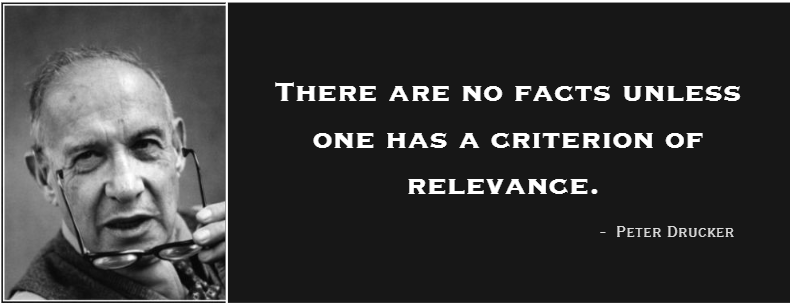|
This post first appeared as Steve Wunker's piece for LinkedIn
Beware “facts.” In our pursuit of data-driven decisions, we tend to skip recognizing perspective and instead jump straight to unquestioned facts. This is when big mistakes can happen. Consider why Peter Drucker, arguably the greatest management scholar of the past century, distrusted facts: “Most books on decision-making tell the reader: First find the facts. But executives who make effective decisions know that one does not start with facts. One starts with opinions…The understanding that underlies the right decision grows out of the clash and conflict of divergent opinions and out of serious consideration of competing alternatives. To get the facts first is impossible. There are no facts unless one has a criterion of relevance.” Drucker states five reasons why: 1. If we do not make opinions clear, we will simply find confirmatory facts. “No one has ever failed to find the facts they are looking for.” 2. An opinion provides an untested hypothesis. Once we have clarified the hypothesis, we can test it rather than argue it. 3. Decisions are often judgments, not a choice between right and wrong. So we must understand the alternatives fully. 4. Big decisions may require new criteria. “The effective decision-maker assumes that the traditional measurement is not the right measurement…The traditional measurement reflects yesterday’s decision.” 5. Ironically, opinions break executives free of pre-conceptions and poor imagination. Disagreement is a safeguard against that. Consider how Drucker’s view contrasts with the typical corporate process. Decision makers may have a general sense of stakeholders’ opinions, but in their eagerness to act and to avoid controversy they do not probe to understand these perspectives fully. Rather, they quickly make a decision and then marshal facts to support it. A company channeling Drucker would tackle matters quite differently. It would: ► Surface opinions very clearly ► Push executives to state the measure of a good decision, pushing them to think about criteria for future success rather than historical metrics ► Insist that opinions be linked to fact-based tests that would validate or disprove the view ► Frame a decision as a true choice between well-elaborated and mutually exclusive alternatives. Rather than focus the process on getting the right answer, it would anchor on asking the right questions. In a time of major shifts in our economy, when disruptive forces seem to lurk around every corner, Drucker’s insight of 50 years ago is more pertinent than ever. By all means, find the facts and create agreement. But first know the opinions and seek dissent. Read the full excerpt from Harvard Business Review, “Why Peter Drucker Distrusted Facts" By Steve Wunker Comments are closed.
|



6/7/2023